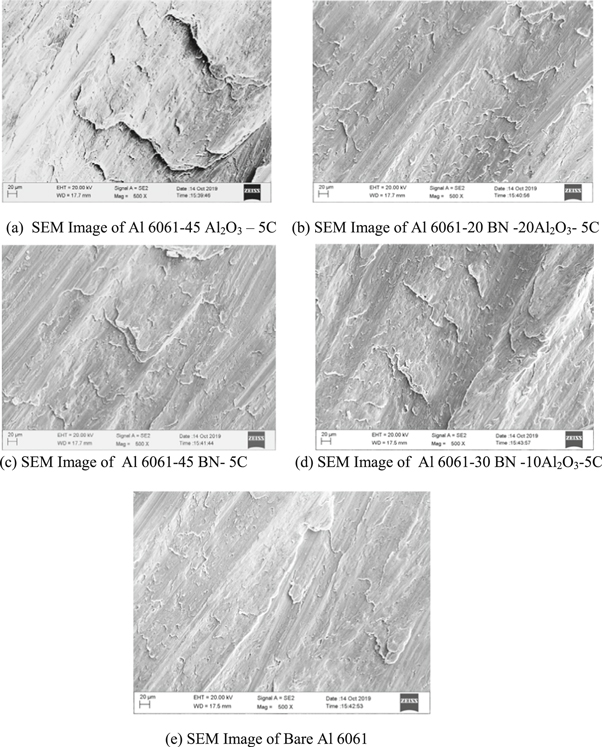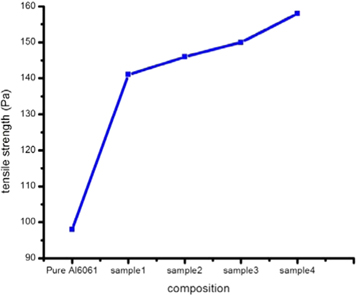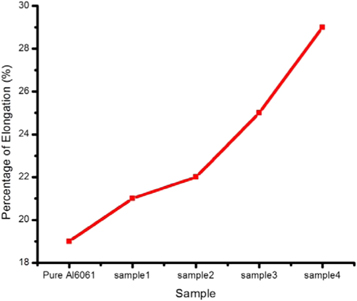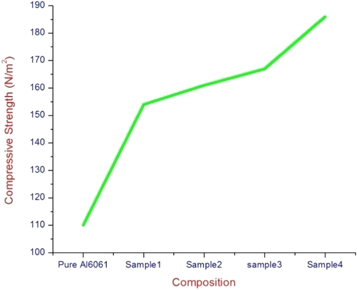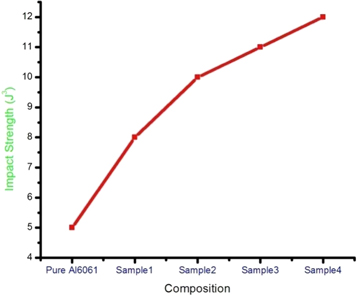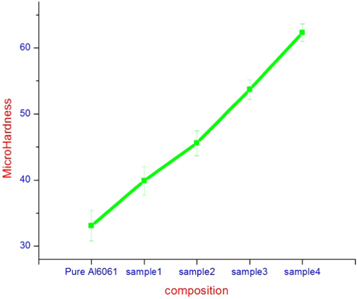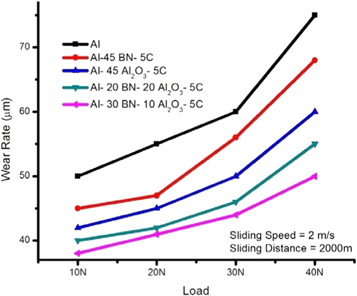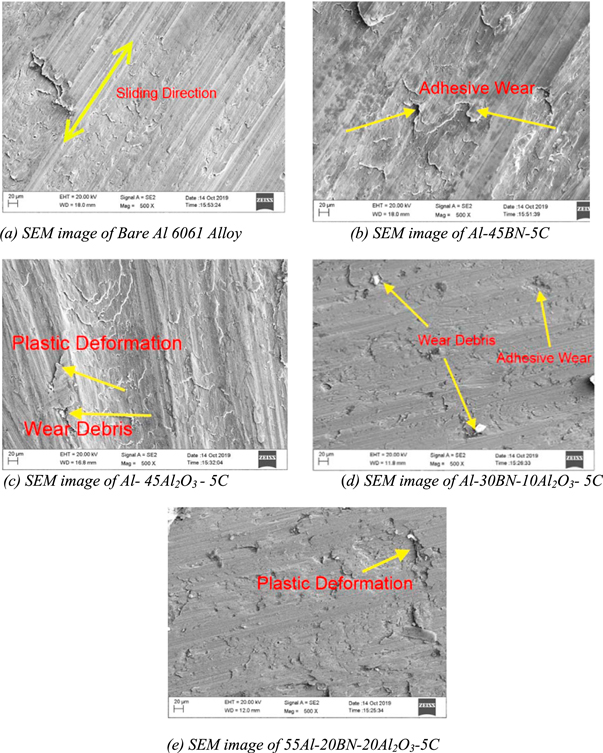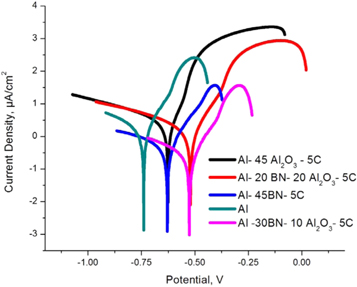Abstract
This research paper portrays the enrichment of mechanical, wear and corrosion properties of the Aluminium 6061 matrix composite by incorporating hybrid reinforcements. Aluminium 6061 alloy is stir casted with different proportions of boron nitride (BN), Aluminium oxide (Al2O3) and graphite particles. Tensile test reveals that the tensile strength and ductility for the Al 6061-30 BN -10Al2O3- 5C is improved due to the presence of higher BN content along with 10% Al2O3. Significant improvement in microhardness (63HV), compressive strength (187 Pa) and impact strength (12 J) for the Al 6061-30 BN -10Al2O3- 5C when compared with the bare Al 6061 alloy. The dispersion of BN with Al2O3 improved the wear resistance for the Al 6061-30 BN -10 Al2O3- 5 C composite, where as the unreinforced bare Al alloy has caused the major surface degradation resulting in poor wear property and the worn out surfaces are examined through the scanning electron microscope. The main wear mechanism is identified as adhesive wear. The corrosion test results clearly reveals that the corrosion resistance is higher for the Al 6061-30 BN -10Al2O3- 5C (−0.526 ± 0.004 V) with a lower current density of −0.983 ± 0.004 μA cm−2 than the other composites and bare Al 6061.
Export citation and abstract BibTeX RIS

Original content from this work may be used under the terms of the Creative Commons Attribution 4.0 licence. Any further distribution of this work must maintain attribution to the author(s) and the title of the work, journal citation and DOI.
1. Introduction
As the technology is blooming at a fast pace in the engineering sector, more reliable and economical engineering materials are on a high demand to satisfy the customer's need. Aluminium 6061 alloy is used as a promising material in the applications of structural and functional sectors, as they possesses medium strength to weight ratio, high corrosion resistance, decent mechanical properties and can be easily heat treated [1]. Nowadays, metal matrix composites are used by many researchers to properly balance the mechanical, tribological and corrosion behaviour for the Aluminium 6061 alloys in specific environmental conditions [2]. The incorporation of reinforcements in a single, double and hybrid manner paved way in attaining higher engineering properties inside the composites [3]. Apart from single reinforced metal matrix composites, hybrid aluminium metal matrix composites are focussed deeply by many authors as they provoke and balance the tribological, mechanical property and corrosion property through the incorporation of various reinforcements like metal nitrides, carbides, borides and oxides [4–6]. As far as the mechanical and wear properties are concerned, many researchers substitute aluminium oxide as the reinforcing element in the Al 6061 hybrid composites due to their high mechanical strength, hard, wear resistance and high stiffness [3, 7]. The introduction of aluminium oxide particles promoted higher hardness, tensile and compression strength due to the good wettability between the Al 6061 matrix and Al2O3 and fine dispersion of the reinforcement inside the composite lamina [7]. Yashpal et al developed a hybrid Al 6061 matrix composites with (6%–8%–10%) of Al2O3 along with (2%–4%) of fly ash. The microhardness is fairly increased due to the well distribution of Al2O3 with fly ash inside the composite [8]. Bharath et al proposed a single reinforced Al 6061 matrix composites with (6, 9, 12%) of Al2O3 as the reinforcement. It is reported that the particles of Al2O3 inside the composites promotes uniform dispersion and had a good grain refinement which paved way for the higher hardness, tensile and wear properties. Also, it is reported that the hike in Al2O3 reinforcement content increases the wear resistance, hardness and tensile strength, where as the ductility decreases linearly [9].
Among the other reinforcements, nitrides have a good wear and corrosion resistance behaviour due to its hardened crystalline structure and chemically stable nature. The hexagonal boron nitride, when combining with Al2O3 has established a higher mechanical and wear characteristics in the hybrid Al matrix composites [10]. Akshay et al reported that the tensile, yield strength and hardness by introducing the fine boron nitride particles with the Al 6061 through the friction stir processing technique. The natural crystalline structure of boron nitride uniformly transferred the load and enriched the grain inside the composites [11]. The inclusion of boron nitride is not only promoted the mechanical and wear strength, but also increases the corrosion resistance of the composites. Kheirkhah et al developed an Al 6061/BN surface composite through friction stir processing method. The presence of boron nitride imparted decent mechanical strength and also the corrosion resistance is improved further. Addition of proper proportion of boron nitride stimulates the mechanical, wear and corrosion behaviour for the Al 6061 composites [12]. The sliding wear characteristics for the Al 6061 composites are higher and there were no massive degradation of the composites. Boron nitride reinforced Al composites provided a minimum wear rate than the bare alloy [13]. Paydar et al studied the wear and corrosion resistance of the electroplated nickel matrix composites through the boron nitride and boron carbide deposition. The BN particle concentration in the deposition has maximized the corrosion resistance than the bare nickel coating [14]. Aluminium 7075 composites having 3% BN and 6% zirconium dioxide showed the higher mechanical strength with decent wear resistance. (What is the role of 3% BN). The uniform distribution of both the particles has led way for the best results [15]. Graphite particles plays a vital role in the hybrid Al 6061 matrix composites, as they have the self lubricating property, brittle and hard materials. Many researchers used graphite as one of the reinforcements mainly because of their good hardness and wear resistance [16–19]. Lokesh et al developed a single reinforced Al 6061 matrix composites with 2%–8% graphite reinforcement. The hardness and tensile strength are higher for the 4% graphite content and also the ductility gets decreases with larger graphite content. The tensile strength is 1.8 times higher when comparing with the bare Al 6061 alloy [16].
From the literature survey, it is concluded that the various experimentations conducted for both single and hybrid reinforced Al 6061 matrix composites through stir casting method results in producing optimal engineering properties. But recently, there is less attention focussed on incorporating boron nitride material as reinforcement in the Aluminium 6061 matrix composites through the stir casting method, as this material possesses better mechanical, wear, thermal and corrosion resistance [13, 14]. This paper aims to incite the mechanical, wear and corrosion behaviour of the stir casted Al 6061 hybrid composites with boron nitride, aluminium oxide and graphite as the reinforcement and make them superior than the bare Al 6061 alloy.
2. Materials and methods
2.1. Materials
In this research work, Al 6061 alloy is used as the matrix material due to its superior engineering properties. The boron nitride (BN), aluminium oxide (Al2O3) and graphite (C) powders are deployed as reinforcements for making the hybrid Al 6061 matrix composites. Boron nitride (BN) with density of 3.75 g cm−3 and particle size of 75 μm is used as one of the reinforcement powder. Aluminium oxide powder (Al2O3) with density of 3.75 g cm−3 and particle size of 50 μm is used as secondary reinforcement. The graphite particle (C) of 60 μm is used as third reinforcement. All the raw materials used in this research work are of research grade with purity levels of 99.5% respectively.
2.2. Fabrication of hybrid composites
The fabrication of the Al 6061 hybrid composites is carried out using the economical stir casting process. Initially, 330 gm of Al 6061 rod is melted in the furnace up to 800°C and is converted to the molten state. The reinforcement materials are then blended in various proportions using mortar. Homogenously mixed reinforcements are preheated to a temperature of 180°C and then gradually added into the molten Al 6061 inside the furnace by a graphite stirrer at 600 rpm. The stirring is uniformly maintained for 2 min at three portions like the lower part, middle one and the upper part of the molten composite inside the furnace. Finally, the molten Al hybrid composite are extracted and casted as a rectangular block. The fabricated Al hybrid composites are characterized using Scanning Electron Microscope (SEM) and Energy Dispersive spectroscopy (EDS). The figure 1 shows the SEM images of various Stir Casted Al 6061 hybrid composites before wear test.
Figure 1. SEM Images of Various Stir Casted Al 6061 hybrid composites.
Download figure:
Standard image High-resolution image2.3. Tensile test
The fabricated hybrid Al composites are subjected to tensile test so as to study the ultimate tensile strength and percentage of elongation of the hybrid composites. The tensile test is carried out using universal testing machine (TUE –C-1000) model as per ASTM E8 M-04 standard. The tensile test samples are prepared using Electrical Discharge Machine (EDM).
2.4. Compression test
The Compression test is carried out using computerized universal testing machine (TUE –C-1000) l as per ASTM E9-89 standard at a feed rate of 5 mm min−1. The specimen surface is kept perpendicular to the die surface.
2.5. Impact test
Charpy test is proposed to calculate the impact strength for all the casted samples as per the ASTM E23 standard procedure using impact testing machine.
2.6. Microhardness test
The microhardness of the Al hybrid composites are calculated using Vickers hardness testing machine as per the ASTM E92 standard. The pyramid shaped indenter is forced against the test specimen at the maximum load 0.5 kgf and corresponding HV values are obtained for all the tested samples. The standard dwell period of 15s is kept constant. The average hardness value of five different replicate tests on the specimen is taken.
2.7. Wear analysis
The wear performance is studied for all the casted samples as per the ASTM G99 standard procedures using pin on disk tribometer. The load is applied for all the samples from 10–40 N and sliding speed and sliding distance is maintained at 2 m s−1 and 2000 m respectively. Finally the wear rate and frictional force are calculated and plotted through graph for each samples.
2.8. Electrochemical corrosion test
The electrochemical corrosion test is carried out using Biologic Sp-150 workstation. The setup of the electrochemical test consists of aluminium hybrid alloys as working electrode and Ag/AgCl as a electrode for reference and a thin platinum wire is used as a counter electrode. The electrochemical tests are carried out using 5 Wt% NaCl solutions as electrolyte. The scan rate of 10 mV s−1 is employed to obtain the potentiodynamic polarization behaviour of the aluminium 6061 hybrid alloys.
3. Results and discussion
3.1. Tensile test
From the tensile test results, it can be concluded that the incorporation of both boron nitride (30%) and aluminium oxide (10%) with graphite (5%) promoted the tensile strength than the sample having equal proportions of boron nitride and aluminium oxide and the other reinforced samples. The strength is enhanced due to the addition of Al2O3 with larger proportion of boron nitride inside the composites. Basically the load bearing capacity is good for both BN and Al2O3 due to the hard nature of BN and Al2O3 particles [10]. The increase in tensile strength may be attributed due to the homogenous blending of reinforcements alone with the Al matrix which in turn reduces the porosity inside the composites that helps in promoting uniform distribution of load. On focussing the Al 6061-20 BN -20Al2O3- 5C composite, they had a decent increase in tensile property having 150 Pa, when compared with the bare alloy, but failed to meet the Al 6061-30 BN -10Al2O3- 5C composite's strength due to the less metal nitride content. Composites Al 6061-45 Al2O3–5C and Al 6061-45 BN—5C has failed to distribute the tensile load (147, 142 Pa) as the reinforcements were not dispersed uniformly inside the lamina with the presence of some voids. Finally, Al 6061-30 BN -10Al2O3- 5C composite had a higher tensile strength of 158 Pa than the other composites and their corresponding tensile test data is furnished in the table 1. The composite Al 6061-30 BN -10Al2O3- 5C has a better elongation percentage at break compared to that of bare Al 6061 alloy and other proportions of Al hybrid composites. The figure 2 shows the graphical representation of tensile strength of various casted Al hybrid composites.The figure 3 shows the graphical representation elongation of various Al hybrid composites. The Percentage of elongation of the hybrid composites increases with increase in reinforcement as shown in figure 3.
. Table 1.Tensile Test Report for the various Al hybrid composites.
| S.No | Sample No | Composition | Tensile Strength (Pa) | Percentage of Elongation % |
|---|---|---|---|---|
| 1. | Bare Al 6061 | 0 | 98 | 19 |
| 2. | Sample 1 | Al 6061-45 BN—5C | 142 | 21 |
| 3. | Sample 2 | Al 6061-45 Al2O3—5C | 147 | 22 |
| 4. | Sample 3 | Al 6061-20 BN -20Al2O3- 5C | 150 | 25 |
| 5. | Sample 4 | Al 6061-30 BN -10Al2O3- 5C | 158 | 29 |
Figure 2. Graphical plot comparing the Tensile strength (Pa) for the various casted samples with the bare Al 6061.
Download figure:
Standard image High-resolution imageFigure 3. The graphical representation of percentage of elongation of various Al hybrid composites.
Download figure:
Standard image High-resolution image3.2. Compression test
The compression test result concluded that the particles of both the boron nitride and aluminium oxide powder were well distributed without any room for voids and porosity in the composite Al 6061-20 BN -20Al2O3- 5C and Al 6061-30 BN -10Al2O3- 5C. The Al 6061-30 BN -10Al2O3- 5C composite has shown a higher compressive strength of 187 N/m2 followed by Al 6061-20 BN -20Al2O3- 5C composite having 167 N m−2. This hike was due to the larger content of hard structured BN and Al2O3 reinforcements in the Al matrix. On viewing the composite Al 6061-45Al2O3 –5C and Al 6061-45BN–5C, they were failed to compensate the compressive stress (160 N m−2, 156 N m−2) due to the poor colliding nature and uneven distribution of single reinforcements with the matrix lamina [20]. Finally the sample having larger BN content with proper Al2O3 proportion showed a decent compressive strength around 187 N m−2. The corresponding test results are shown in the table 2 for the various casted composites. The percentage of deformation of the Al 6061-30BN -10Al2O3-5C composite has the lower deformation percentage of 10% where as the Pure Al 6061 has a deformation percentage around 18%. The figure 4 depicts the Graphical plot comparing the Compressive strength (N m−2) for the various casted samples with the bare Al 6061. The figure 5 shows the graphical presentation of deformation percentage of various Al hybrid composites.
Table 2. Compression Test Report for the various Al hybrid composites.
| S.No | Sample No | Composition | Compressive Strength (N m−2) | Percentage of deformation % |
|---|---|---|---|---|
| 1. | Bare Al 6061 | 0 | 109 | 18 |
| 2. | Sample 1 | Al 6061-45 BN—5C | 156 | 16 |
| 3. | Sample 2 | Al 6061-45 Al2O3—5C | 160 | 15 |
| 4. | Sample 3 | Al 6061-20 BN -20Al2O3- 5C | 167 | 12 |
| 5. | Sample 4 | Al 6061-30 BN -10Al2O3- 5C | 187 | 10 |
Figure 4. Graphical plot comparing the Compressive strength (N/m2) for the various casted samples with the bare Al 6061.
Download figure:
Standard image High-resolution imageFigure 5. The graphical representation of percentage of deformation of various Al hybrid composites.
Download figure:
Standard image High-resolution image3.3. Impact test
As far the Charpy impact test is concerned, the composite Al 6061-45Al2O3 –5C and Al 6061-45BN–5C showed better impact strength when comparing with bare Al alloy. The influence of boron nitride in Al 6061-45 BN—5C composite and Al2O3 in Al 6061-45 Al2O3—5C had more energy absorption capacity, irrespective of the impact load applied, while the bare Al alloy failed to compensate the impact stress. The impact strength was tailored due to the combined effect of hybrid reinforcements for the remaining Al 6061 composites. The composite Al 6061-20 BN -20Al2O3- 5C and Al 6061-30 BN -10Al2O3- 5C paved way for higher impact strength around 10.8 and 12 (J3). This strength was attained due to the equal contribution made by two reinforcements, as both of them has a better toughness and shock absorbing capacity. From the comparison, it was concluded that the composite Al 6061-45Al2O3 –5C and Al 6061-45BN–5C showed a low impact strength around 7.9 and 9.9 J3 when compared with the composite Al 6061-20 BN -20Al2O3- 5C and Al 6061-30 BN -10Al2O3- 5C with a higher value. The bare alloy failed to absorb the impact energy and finally attained the impact strength of 5.1 J3. The Al 6061-30 BN -10Al2O3- 5C composite had superior impact strength of 12 J3 and the appropriate tested data is tabulated in table 3. The graphical representation of the Impact strength (J3) for the various casted samples and the bare Al 6061alloy are shown in figure 6.
Table 3. Impact Test (Charpy) Report for the casted samples with various nature of reinforcement.
| S.No | Sample No | Composition | Impact Strength (J3) |
|---|---|---|---|
| 1. | Bare Al 6061 | 0 | 5.1 |
| 2. | Sample 1 | Al 6061-45 BN—5C | 7.9 |
| 3. | Sample 2 | Al 6061-45 Al2O3—5C | 9.9 |
| 4. | Sample 3 | Al 6061-20 BN -20Al2O3- 5C | 10.8 |
| 5. | Sample 4 | Al 6061-30 BN -10Al2O3- 5C | 12 |
Figure 6. Graphical plot comparing the Impact strength (J3) for the various casted samples with the bare Al 6061alloy.
Download figure:
Standard image High-resolution image3.4. Microhardness test
The microhardness values for the above casted samples were determined using Vicker's method as per the ASTM E92 standard procedure. From the test reports, it was clearly proved that the hybrid reinforced Al 6061 composites had a higher hardness data than the other samples and bare Al alloy. The inclusion of boron nitride, Al2O3 with graphite content promoted active hardened surface structure in the Al 6061 lamina. Basically, both these reinforcements (BN, Al2O3 & C) have a superior hardness property due to their crystal structure, the HV values for the composite Al 6061-30 BN -10Al2O3- 5C was quite higher than the Al 6061-20 BN -20Al2O3- 5C composite, as the content of cubic boron nitride was reasonably large in sample 4 than that of the Al2O3. The dispersion between these two reinforcements along with graphite paved a higher HV values than the other composites. The microhardness values were found to be around 54 and 63 HV for the Al 6061-20 BN -20Al2O3- 5C and Al 6061-30 BN -10Al2O3- 5C composites, whereas the sample Al 6061-45Al2O3 –5C and Al 6061-45BN–5C had a lesser HV of 46 and 40 . Bare Al 6061 alloy had a least HV value of 33. The Graphical representations of Microhardness (HV) for the various casted samples are shown in figure 7. The vicker's hardness values of different hybrid composites are enlisted in the table 4.
Figure 7. Graphical plot comparing the Microhardness values (HV) for the various casted samples with the bare Al 6061.
Download figure:
Standard image High-resolution imageTable 4. Vicker's Microhardness Test Report for the casted samples with various nature of reinforcement.
| S.No | Sample No | Composition | Microhardness value (HV) |
|---|---|---|---|
| 1. | Bare Al 6061 | 0 | 33 |
| 2. | Sample 1 | Al 6061-45 BN—5C | 40 |
| 3. | Sample 2 | Al 6061-45 Al2O3—5C | 46 |
| 4. | Sample 3 | Al 6061-20 BN -20Al2O3- 5C | 54 |
| 5. | Sample 4 | Al 6061-30 BN -10Al2O3- 5C | 63 |
3.5. Wear analysis
The figure 8 shows the wear rate of the pure aluminium and aluminium hybrid alloys at various loading conditions starting from 10N to 40N. The sliding speed and sliding distance was kept constant at 2 m s−1 and 2000m respectively. The wear rate of the alloys increases with increase in the applied load. The pure aluminium alloy has showed the wear rate of 75 μm at 40 N whereas the Al-30BN-10Al2O3 -5C exhibited 48 μm at same loading condition of 40 N. From the figure 8, it is obvious that the addition of BN, Al2O3 and C decreases the wear rate of the alloys as compared to that of pure Aluminium alloys. The reason behind this improvement in wear resistance was due to the hard BN and Al2O3 particle reinforcement. Moreover the addition of 5% graphite particles has improved the self lubricating properties of the hybrid alloys which also played a vital role in the improvement of wear resistance. The Coefficient of Friction (COF) values of the pure aluminium and aluminium hybrid alloys is shown in figure 9. The COF values of hybrid alloys had shown improvement when compared to pure aluminium at all loading conditions. The COF value of pure aluminium was found to be around 14 for the applied load of 40N, whereas the COF values of Al-45BN-5C alloy has reduced to 11.5 at same loading condition. This reduction in the COF value was due to the hard BN reinforcement along with self lubricating graphite reinforcement. The Al-45Al2O3- 5C alloys exhibited the COF value of 9, which is found to be better than Al-45BN-5C alloy. The reason behind this improvement may be attributed to the Al2O3 reinforcement. The smooth morphology and hard nature of Al2O3 reinforcement may be one of the reasons for the reduction in COF value [21]. The COF value of Al-20BN- 20 Al2O3 -5C alloy was found to be around 8 but the Al-30BN- 10 Al2O3 -5C alloys represented better COF value of 5 compared to other hybrid alloys. From the SEM analysis as shown in the figure 10, the collaboration made between the hard particles of BN and Al2O3 were fine with defect free lamina. There were no group formation inside the composite lamina and equal distribution made them a superior composites. The main wear mechanism was identified as adhesive wear followed by plastic deformation due to the soft nature of the Aluminium matrix. The EDS data as shown in the figure 11, illustrated that all the ingredients inside the lamina are at the proper percentage.
Figure 8. Wear rate of Aluminium hybrid Alloys at various Loading Condition.
Download figure:
Standard image High-resolution imageFigure 9. COF of Aluminium hybrid Alloys at various Loading Condition.
Download figure:
Standard image High-resolution imageFigure 10. SEM Images of Various Stir Casted Al 6061 hybrid composites after the wear test.
Download figure:
Standard image High-resolution imageFigure 11. EDS of Al-30BN-10Al2O3-5C hybrid composites.
Download figure:
Standard image High-resolution image3.6. Electrochemical corrosion test
The potentiodynamic polarization test for the pure aluminium and aluminium hybrid alloys was carried out in electrochemical workstation in 5 wt% NaCl solution is represented in the figure 12. The corrosion properties namely corrosion potential (Ecorr) and Current density (Icorr) are determined by using Tafel extrapolation method. The table 5 shows the potentiodynamic polarization test results obtained using Tafel extrapolation method. The results reveal that corrosion potential (Ecorr) of Al- 20 BN- 20Al2O3- 5C alloy was −0.525 V versus Ag/AgCl, whereas the Current density (Icorr) was found to be 0.254 μA cm−2. The Current density of the Al- 30 BN- 10Al2O3- 5C alloy was (−0.983 μA cm−2) which has reduced considerably when compared to pure aluminium (−0.725 μA cm−2) and other hybrid alloys. The corrosion potential (Ecorr) of Al- 30 BN- 10Al2O3- 5C alloy was -0.526 V. So by comparing all the corrosion parameters, even though Al- 30 BN- 10Al2O3- 5C alloy has a slightly higher corrosion potential (Ecorr) compared to Al- 20 BN- 20Al2O3- 5C alloy, it has the better Current density (Icorr) value which is the important factor in judging the corrosion resistance of an alloy. The bare sample faced pitting corrosion during the test due to the incapability of resisting the metal oxide formation and presence of voids paved way for severe corrosion [22, 23]. The presence of nitride and graphite content promoted a strong barrier against the pitting corrosion in the Al- 20 BN- 20Al2O3- 5C and Al- 30 BN- 10Al2O3- 5C composites. Hence from the corrosion studies, it can be concluded that Al- 30 BN- 10Al2O3- 5C alloy has better corrosion resistance than other combination of alloys and respective data were plotted in table 5.
Figure 12. Tafel Plots of Aluminium hybrid Alloys.
Download figure:
Standard image High-resolution imageTable 5. Electrochemical Corrosion test results.
| S.No | Specimen | Ecorr (V) | Icorr (μA/cm2) |
|---|---|---|---|
| 1 | Al | −0.749 ± 0.011 | −0.725 ± 0.020 |
| 2 | Al-45BN- 5C | −0.625 ± 0.053 | −0.520 ± 0.010 |
| 3 | Al-45Al2O3- 5C | −0.624 ± 0.123 | 0.525 ± 0.015 |
| 4 | Al- 20 BN- 20Al2O3- 5C | −0.525 ± 0.010 | 0.254 ± 0.006 |
| 5 | Al- 30 BN- 10Al2O3- 5C | −0.526 ± 0.004 | −0.983 ± 0.004 |
4. Conclusion
Aluminium 6061 hybrid composites with different proportions of boron nitride, aluminium oxide and graphite are processed through the economical stir casting process. Mechanical properties, wear and corrosion behaviour have been studied as per the standards.
- The tensile strength and ductility are higher for the Al 6061-30 BN -10Al2O3- 5C composite due to the inclusion of higher percentage of BN along with Al2O3.
- Al 6061-30 BN -10Al2O3- 5C composite exhibit a higher compressive strength with lesser percentage of deformation, as these composites have a uniform distribution among the reinforcements with lesser voids.
- It is concluded from the impact test that both the Al 6061-20 BN -20Al2O3- 5C and Al 6061-30 BN -10Al2O3- 5C composite show the maximum impact strength due to the presence of boron nitride and Al2O3.
- Micro hardness is enhanced for Al 6061-30 BN -10Al2O3- 5C composite due to the presence of hard structured BN reinforcement along with graphite.
- The wear analysis results shows that Al 6061-30 BN -10Al2O3- 5C composite have experienced the maximum wear resistance and a decent coefficient of friction than the other hybrid composites and bare Al 6061 alloy. The increase in wear property is due to the combined effect of BN and C, as both the elements are self lubricating in nature and hardened particles. The main wear mechanism is identified as adhesive wear followed by plastic deformation due to the soft nature of the aluminium matrix.
- It is evident from the electrochemical potentiodynamic polarization test data, Al 6061-30 BN -10Al2O3- 5C composite has the superior corrosion resistance of (-0.526 ± 0.004 V) with a lower current density of −0.983 ± 0.004 μA cm−2 than the other composites in 5 wt% NaCl solution.
- From the experimental report, it can be concluded that the Al 6061-30 BN -10Al2O3- 5C composite has a better mechanical property, wear and corrosion resistance than the bare Al 6061 alloy.


